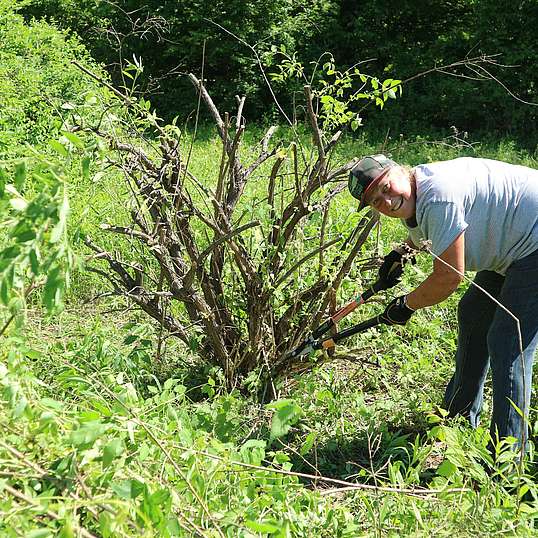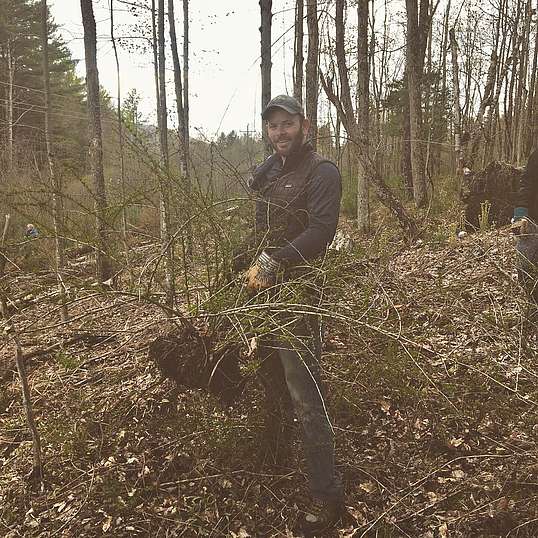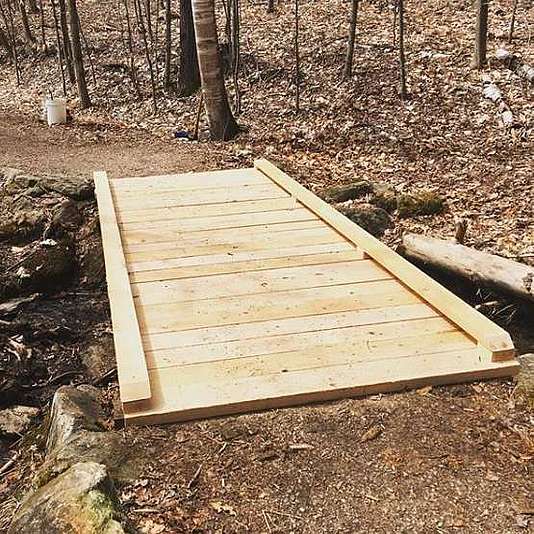
Stewardship Projects
Caring for conserved land is a forever job—one we take seriously and enjoy. Each season brings new and different challenges to our properties, and we couldn’t do it all without your help! Visit our Volunteers page for more information on how you can SLT care for the land.

Kirchner Woods Adaptive Bike Trails
In Summer 2024 and 2025, SLT contracted with Stowe Trails Partnership and Vermont Adaptive to upgrade over a mile of trail at Kirchner Woods that are already open to mountain bikers to make them accessible to adaptive bikers. The trail upgrades also better accommodate a wider variety of other recreational users. Whether you are an adaptive biker or are simply going for a quiet walk in the woods, we invite you to come out and enjoy an improved trail experience!

Mill Trail Universal Access Trail
We are upgrading the main trail at the Mill Trail property and adding a new side trail from the main trail to the historic Moravian Cabin that meet US Forest Service Universal Access Requirements to make the property more accessible to all!
In partnership with Timber & Stone LLC and with the help of community volunteers, Phase 1 work was completed during Summer 2025 and improved the main trail by replacing two washed out culverts with new bridges and replacing worn-out decking on a third bridge. Phase 2 work to create a new universal access side trail to the Moravian Cabin and regravel the main trail to meet universal access requirements will take place in Summer 2026.

Adams Camp Connector Trails
Planning with our trail partners - Stowe Trails Partnership, the Catamount Trail Association, Stowe Nordic, and Stowe Derby/Mount Mansfield Academy - is underway for three-season and winter-only connector trails that will cross the Adams Camp Connector parcel. Information about the planned connector trails can be found here and has also been posted to the Adams Camp and Adams Camp Connector trailhead kiosks.
Wiessner Woods Trail Work
We have been caring for and improving Wiessner Woods' beloved trails since 1992, and our work is never done. Beginning in 2013, we started replacing a handful of aged and rotting bridges each year. In 2021, we rebuilt the Howard Carol Memorial Bridge on the Sugarhouse Loop. In 2023, we gave the Meadow Trail bridges, puncheon, and north overlook some much-needed TLC. Improvements to the Sugarhouse Loop and Hardwood Ridge Trail and up next - stay tuned!

Restoring DuMont Meadow
We are working continuously to restore native biodiversity and habitats at our 50-acre conserved DuMont Meadow property in Moscow.
After inventorying native and invasive plants on the property in 2014, we created a management plan and weed plan to help us meet our goal. We kicked off invasive plant control efforts in spring 2016 by cutting back the infestation of mature non-native, invasive bush honeysuckle plants in the meadow. We then brushhogged the meadow and used an excavator to pull out more mature honeysuckle plants in the fall. In 2017, we continued removing honeysuckle and planted native trees and shrubs along the Little River, resulting in a mosaic of healthy habitats that collectively attract and support a wide array of native plants and animals. In 2018 and 2019 we continued hand pulling honeysuckle sprouts in the meadow with the help of individual volunteers and groups like National Life Group.
When an old white pine fell in the meadow and blocked Alex's Trail, we rerouted the trail to leave the tree in place—creating excellent wildlife habitat and offering protection from predators for small mammals and birds. Thanks to grant funding from the Oakland Foundation we were able to create a trail map and brochure for the property and reprint the meadow’s interpretive signs on a more durable material in 2020. Thanks to enthusiastic volunteers we were also able to cut back nearly all the honeysuckle sprouts in the meadow before having the field brushhogged once again in October 2020 and November 2024.
Today, we continue to fight the good fight against invasive honeysuckle with the help of volunteer groups such as the Laraway School. We are also planning a riparian buffer zone native tree and shrub planting for Spring 2026 with Friends of the Winooski River on the meadow's edge. Sign up for our volunteer list to stay updated on opportunities to get involved!

Removing Invasive Japanese Barberry from Cady Hill Forest
Cady Hill Forest is a great example of cooperative management of a community resource. Conserved in 2012, Cady Hill Forest is owned by the Town of Stowe, who has an agreement with Stowe Trails Partnership to manage the extensive trail system. The property is also subject to a conservation easement co-held by Stowe Land Trust and the Vermont Housing and Conservation Board. Since 2015, the Town of Stowe and Stowe Land Trust have been working with local organizations and volunteers to tackle Cady Hill's plant problem: an abundance of invasive Japanese barberry.
Originally brought to the United States as an ornamental shrub, Japanese barberry has now escaped into Vermont's forests and fields, and if left unchecked will out-compete all other native under-story species until it is the only plant growing in that area. Areas with high barberry populations tend to have increased rates of Lyme disease because the shrubs are at the perfect height for ticks to hang out and wait for a ride, and mice, which are the alternate host for Lyme disease, thrive in the safety of thorny barberry stands.
Since 2015, more than 5,000 barberry plants have been removed with the help of volunteers from Vail, National Life Group, Laraway School, and Bishop Marshall School, to name a few. With funding from the Patagonia Retailer’s grant through A.J.’s Ski & Sports, Stowe Land Trust and the Stowe Conservation Commission was able to hire a professional crew from Burlington’s Intervale Conservation Nursery to assist with removal efforts in 2018, 2019, and 2020. This experienced crew able to tackle some of the tougher areas—like the wetland under the powerlines—that volunteers would not have been able to get to.
Completely eradicating Japanese barberry from Cady Hill Forest would be nearly impossible, but our efforts have been very effective in keeping it contained to the powerlines and away from the recreational trails. With that goal in mind, we will continue to monitor the property and together with our volunteers and partners, work to limit the plant’s spread.
